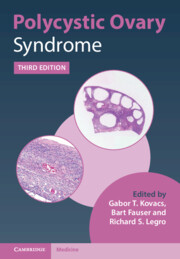Book contents
- Polycystic Ovary Syndrome
- Polycystic Ovary Syndrome
- Copyright page
- Contents
- Contributors
- Chapter 1 Introduction to and History of Polycystic Ovary Syndrome
- Chapter 2 Polycystic Ovary Syndrome: From Phenotype to Genotype
- Chapter 3 The Epidemiology of Polycystic Ovary Syndrome
- Chapter 4 Ovarian Ultrasonography in Polycystic Ovary Syndrome
- Chapter 5 The Classification of Polycystic Ovary Syndrome Informed by the International Guideline 2018
- Chapter 6 The Relevance of the Anti-Müllerian Hormone in Polycystic Ovary Syndrome Diagnosis and Management
- Chapter 7 Origins of Polycystic Ovary Syndrome In Utero
- Chapter 8 Adrenal and Polycystic Ovary Syndrome
- Chapter 9 Polycystic Ovary Syndrome and Environmental Toxins
- Chapter 10 Lifestyle in Polycystic Ovary Syndrome
- Chapter 11 Ovulation Induction in Polycystic Ovary Syndrome
- Chapter 12 Ovarian Surgery for Ovulation Induction
- Chapter 13 In Vitro Fertilization and Assisted Reproductive Technologies in Polycystic Ovary Syndrome
- Chapter 14 Pregnancy Complications and Children Outcomes in Patients with Polycystic Ovarian Syndrome
- Chapter 15 The Role of In Vitro Maturation in Polycystic Ovary Syndrome
- Chapter 16 The Treatment of Obesity in Polycystic Ovary Syndrome
- Chapter 17 Mood Disorders in Polycystic Ovary Syndrome
- Chapter 18 The Long-Term Health Consequences of Polycystic Ovary Syndrome
- Chapter 19 Polycystic Ovary Syndrome
- Chapter 20 Cancer and Polycystic Ovary Syndrome
- Index
- References
Chapter 13 - In Vitro Fertilization and Assisted Reproductive Technologies in Polycystic Ovary Syndrome
Published online by Cambridge University Press: 13 May 2022
- Polycystic Ovary Syndrome
- Polycystic Ovary Syndrome
- Copyright page
- Contents
- Contributors
- Chapter 1 Introduction to and History of Polycystic Ovary Syndrome
- Chapter 2 Polycystic Ovary Syndrome: From Phenotype to Genotype
- Chapter 3 The Epidemiology of Polycystic Ovary Syndrome
- Chapter 4 Ovarian Ultrasonography in Polycystic Ovary Syndrome
- Chapter 5 The Classification of Polycystic Ovary Syndrome Informed by the International Guideline 2018
- Chapter 6 The Relevance of the Anti-Müllerian Hormone in Polycystic Ovary Syndrome Diagnosis and Management
- Chapter 7 Origins of Polycystic Ovary Syndrome In Utero
- Chapter 8 Adrenal and Polycystic Ovary Syndrome
- Chapter 9 Polycystic Ovary Syndrome and Environmental Toxins
- Chapter 10 Lifestyle in Polycystic Ovary Syndrome
- Chapter 11 Ovulation Induction in Polycystic Ovary Syndrome
- Chapter 12 Ovarian Surgery for Ovulation Induction
- Chapter 13 In Vitro Fertilization and Assisted Reproductive Technologies in Polycystic Ovary Syndrome
- Chapter 14 Pregnancy Complications and Children Outcomes in Patients with Polycystic Ovarian Syndrome
- Chapter 15 The Role of In Vitro Maturation in Polycystic Ovary Syndrome
- Chapter 16 The Treatment of Obesity in Polycystic Ovary Syndrome
- Chapter 17 Mood Disorders in Polycystic Ovary Syndrome
- Chapter 18 The Long-Term Health Consequences of Polycystic Ovary Syndrome
- Chapter 19 Polycystic Ovary Syndrome
- Chapter 20 Cancer and Polycystic Ovary Syndrome
- Index
- References
Summary
In vitro fertilization (IVF) should be viewed as a third-line treatment for those with polycystic ovary syndrome (PCOS). In the absence of known causative factors of infertility, such as tubal or sperm abnormalities, a methodical approach to treatment should first include lifestyle modification and an efficacious trial of ovulation induction (OI). Cumulative pregnancy rates of 62% within 4 treatment cycles have been shown with letrozole, an aromatase inhibitor[1] – now widely accepted as the first-line OI agent in PCOS.[2, 3] For those who remain refractory to different regimens of OI, the move to IVF, with the associated risk of ovarian hyperstimulation syndrome (OHSS), becomes justified. The presence of polycystic ovaries is a major risk factor for OHSS, necessitating careful planning of gonadotropin stimulation.
- Type
- Chapter
- Information
- Polycystic Ovary Syndrome , pp. 121 - 130Publisher: Cambridge University PressPrint publication year: 2022



